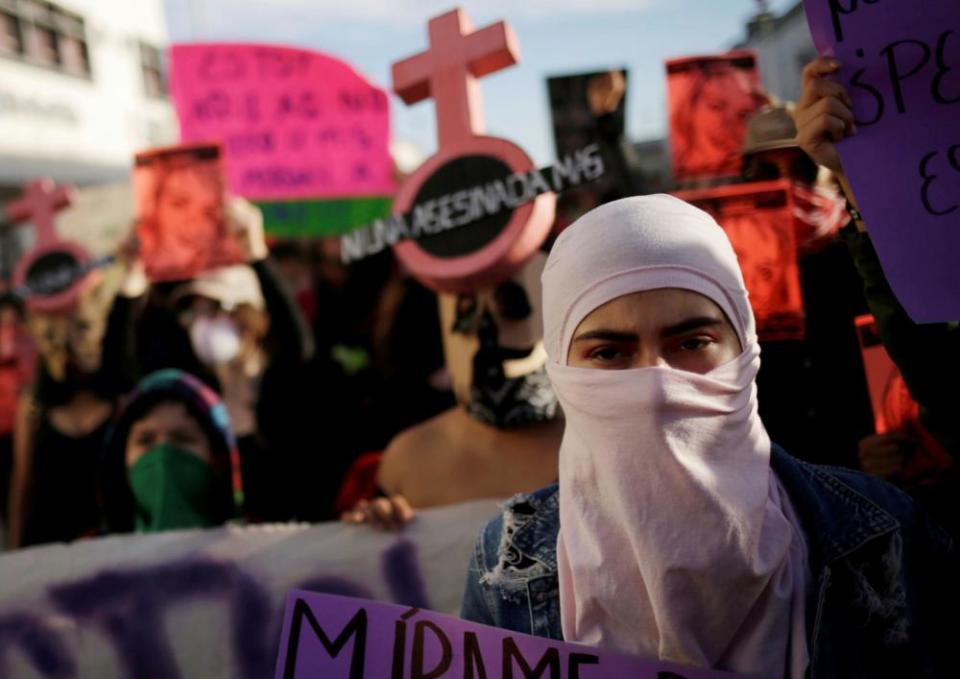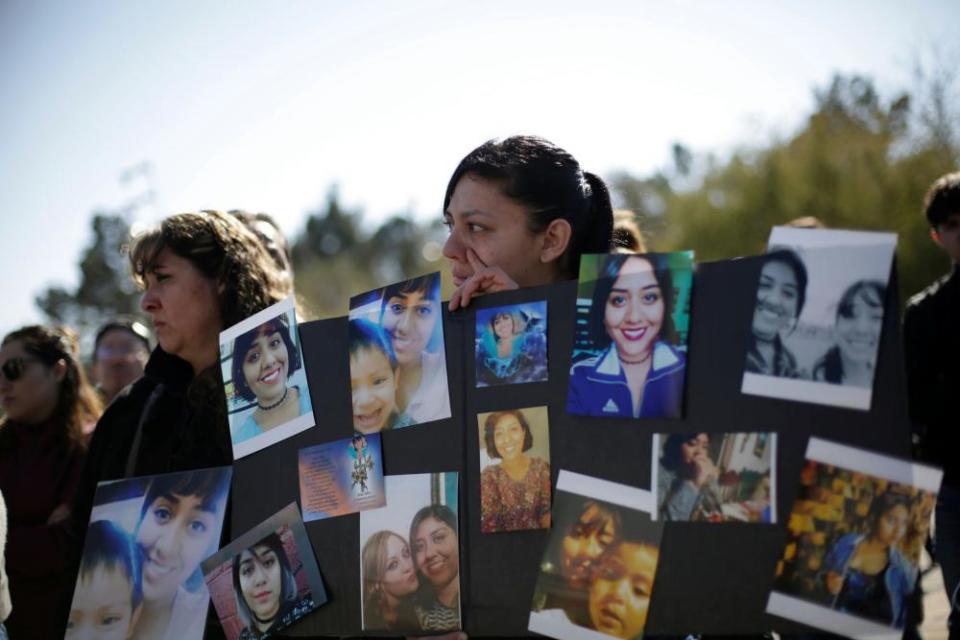'Why did she have to die?' Mexico's war on women claims young artist

They gathered in the chill of a high desert night, around a bakery on a street corner in the US-Mexican border city of Ciudad Juárez, to blend homage with mourning, love with sorrow.
Opposite them: a mural of painted eyes and the words “Te observan” – they’re watching you. And a self-portrait by the artist, Isabel Cabanillas de la Torre, 25, shedding a tear. It is a prescient touch: at the foot of the painting is a floral tribute to Cabanillas, who was shot in the head on 18 January while cycling home.
Days of rage followed: marches downtown blocking the Santa Fe border bridge; women wearing pink balaclavas to commemorate the victims of the rash of murders of women in Juárez during the 1990s and 2000s – of which this outrage is the latest mutation.
Tonight is music, conversation and celebration of Isabel’s metier: art, for sale tonight at voluntary prices towards a fund for her now motherless four-year-old son. “We’re doing what she would have wanted us to do”, said Arón Venegas, the founder of Pure Borde, the art collective to which Isabel belonged.
Lydia Graco, a member of Pure Borde, said in a heart-wrenching moment: “Isa, we’re sorry we couldn’t stop your femicide. Forgive us, Isa, please. We owe you, comrade, we owe you.”
The event was convened by Puro Borde – pure border. “In a city hollowed out by narco war, we try to take back the streets with art, colours and visual ideas,” said Venegas. The event was already scheduled before Isabel was killed. “It’s unbearably tragic she’s not here.”
The last thing Isabel Cabanillas did was enjoy a drink with friends at Eugenio’s bar in central Juárez – a genial, mostly young bohemian joint.
A week after the murder, the bar is full as usual, with chatter and banter about Isabel and not. Cabanillas was “widely known” and “much-loved” across the city, every burrito vendor and tender of the artier bars in central Juárez affirms.
“She was funny,” said Marte, a poet, who, like other female friends of Cabanillas interviewed, used a pseudonym. “She had what I’d call a white humour, rather than black. A pure humour, simple and sensitive. She laughed, and made other people laugh.”
“I remember her well,” said an elderly regular, Carlos, sipping a Dos Equis. “Charming girl, usually with her group, but sometimes chatting with us older folks. If the devil had told me someone would pull a trigger against her, I’d have called him a liar.”
•••
The night she was killed, Isabel bade her friends goodnight and mounted her bicycle, turning right into Calle Ochoa, beside the office of a pensioners’ association and along the pink walls of its courtyard.
Either she was followed, or someone had been positioned to ambush her. Two shots from a high-calibre revolver were fired into her chest and head – a cold-blooded, targeted execution. Video cameras appear to give a view of the street, but police have not confirmed the existence of footage, or a motive for the slaying.

Now, in the parched light of afternoon, a pink bicycle is attached to a lamppost on that spot, with daffodils in its basket. The painted slogans speak for themselves: “Isabel vive” – Isabel lives. “Ni una más” – not one more. “Justicia” – justice. But there lies faint hope.
Asked whether they expect any serious attempt at apprehension and trial of the murderer, Cabanillas’s friends replied: “Not a chance.”
“Unthinkable, in this city.”
“Impunity has been the rule,” said one, Arena, a schoolteacher.
Alfredo Carrillo recently began making a film about Puro Borde and its artists. Among the interviewees recorded was Cabanillas: “I have had the privilege or working with one of our most precious soldiers. It’ll be so hard to edit this. I was with her a few weeks ago, crossing the same road in which she was murdered.”
The feminist collective to which Isabel also belonged is called Hijas de su Maquila Madre – roughly: daughters of the factory mothers. Many of the victims of the original femicidio in Juárez were women working in the many gruelling assembly plants, making electronic, industrial and consumer goods for US markets. The plants employed mostly low-paid female labour drawn by the million from the poor interior and south of Mexico to the border, and especially to burgeoning Juárez, where barrios grew in the desert scrub with no infrastructure to support them, and where hundreds of female workers were murdered.
Most members of the Hijas collective are daughters of those workers. All their mothers came to Juárez to work. “We are the first generation born in Juárez,” said Marte, the poet. “Isabel too. And many of us are the first generation in our families to go to university.”
This fact mutates the narrative of femicide in the city, from mainly working-class women and girls, to include this activist, politicised generation.
“We are the daughters of that generation,” said Arena, “and with Isabel’s death, it comes closer to our circles.”
“There is a difference,” observed Procupia, a male colleague and fellow street artist. “This new generation is a new kind of target. Unlike the former victims, these women are organised, hold meetings, targeted not just for being women, but because of what they do.”
Most live together in a squat. “We are so precarious,” said Arena. “We have nothing but our art and our selves.”
“We want it understood that what Isabel was doing was rebellious in Juárez,” emphasised Arena. “In a machista city, she was occupying the streets with art, she was riding her bicycle home alone at night, she was subversive of patriarchal culture. She joined us to fight patriarchal violence in our own ways, her own way.”
She was also “busy against the extraction industries in Chihuahua”, said Sirena. “When she was killed, she was preparing protest art at Salamayuca, south of here, against a Canadian company opening a copper mine.”
“Isabel and I worked together on installations,” said Sirena, a sociologist, “such as hanging clothes on which each stitch represented a disappeared person, or victim of sexual crime” – an estimated 60,000 or more are missing in Mexico’s violence.
“We moved the installation from place to place – suddenly it would appear.”
Eyes are the constant theme in Cabanillas’s art. “She talked about this,” said Arena. “Eyes two-way: our own eyes, with which we observe, and the eyes that survey us. It’s like: we are watching you watching us.”

Procupia added, chillingly: “She wanted to demonstrate that we are all being watched. But it was more than that: she told us she had a feeling that she herself was being watched, specifically, not long before she was killed.”
“Of course, it is not just Isabel,” said Arena. “There are so many invisible, unreported murders of women in this city. Very many women are abducted, disappear and are never seen again – often due to trafficking.”
Sirena added: “There’s been a war against women on the streets of this city since the 1990s. But I’d say the danger was now even greater.”
There were 1,500 murders in Juárez last year – a figure climbing towards the peak of 1,967 in hyper-violent 2011 – and 119 homicides in the city during January this year. Last weekend alone counted 18 murders.
Molly Molloy, an archivist in Las Cruces, New Mexico, who tracks violence in Juárez, cites figures from the Chihuahua attorney general’s office showing that most murders in Juárez since the 1990s – between 85 and 91% – are of males.
But anthropologist Cecilia Ballí has examined the misogynist “style” of killing women – “a word I do not use lightly”, she said – which has taken the nature of violence in the city to another level. In a thesis, Ballí explored this history of “sexual murder” in the context of “hyper-masculinity in US-Mexico border zones, informed by the history, style and logics of militarization and organized crime”.
The “style” of killing in the original wave of murders was unspeakable: violation, torture, bodies dumped in the desert, sometimes with clothing swapped to confound identification.
Then, as now, the question remains: who is responsible, and why?
“We are in no doubt that Isabel’s death was a political, misogynist execution,” said Sirena. “But the sicarios [killers] do not act alone, the mafia does not kill in a vacuum. They get their orders. Even if the authorities catch the killer, they will not catch the intellectual author of the crime. Who is ordering it?”
Professor M – who wants anonymity for safety reasons – at the Autonomous University of Ciudad Juárez, notes the existence in the city of an overtly misogynist organisation called Imperio Alpha – Alpha Empire – which disseminates pornography and insults women on the internet. “They even have a presence in the faculty,” she said.
“Their leader, Jesús Manuel ZN, is in Cesero jail here awaiting trial for extortion, and there was an article in the paper about him, a video he made, the day before Isabel’s murder – who knows?”
The video is menacing and revolting, and raises the question: how was it dispatched from custody?
“We have no evidence of a connection to this group,” said Arena. “All we know is that men around Imperio Alpha are numerous in Juárez, misogynist and aggressive.”
•••
Back at the event to celebrate Isabel’s life, delicious pastries were served, and coffee brewed against the chill of night.
An MC takes to his deck and spins a few records, to ease the solemnity, lighten the leaden reason for the gathering, bring back some of Isabel’s smile.
“She was just, well, lovely,” said Arena. “That’s it, really. Lovely. She should be here with us, and we just cannot understand why or for what she had to die like that.”

